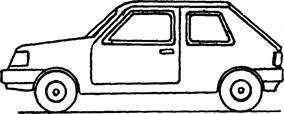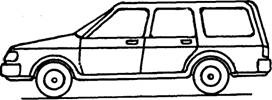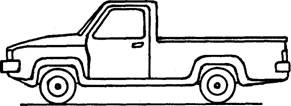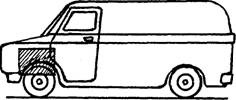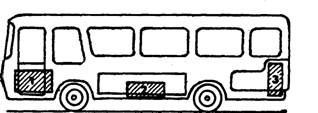1.3. The Motor Car
The motorcar carries passengers in the sitting position and also accomodates their luggage.
Space is also provided for the engine, the transmission system, the steering, the suspension
layout, and the braking system. Finally, consideration is given to the styling of the body to meet
various aesthetics and application requirements.
The light motor vehicles designed to carry passengers and sometimes goods are broadly
classified as follows :
(j) Saloon car (ii) Coupe
[Hi) Convertible (iv) Estate car (v) Pick-up.
Saloon Car. Saloon cars have an enclosed compartment to accommodate a row of front and
row of rear seats (Fig. 1.3) without any partition between the driver and rear-passenger seats.
A separate luggage space is made either at the front or the rear, based on the location of the
engine. One or two doors are provided on each side of the car, but if the car is a hatchback(Fig.
1.4), a door replaces the luggage space.
Coupe. The couple (Fig. 1.5) is the outcome of changes is saloon-car design and has two
doors, two front seats, and a hard roof. When two additional small seats are provided at the
rear, the layout is known as “two-plus-two”.
Fig. 1.3. Saloon car.
Fig. 1.4. Hatchback car.
Fig. 1.5. Coupe car.
Convertible. Normally cars of this type (Fig. 1.6) have two doors and two seats, but
sometimes two extra seats are also provided. Generally these have a soft folding roof and
wind-up windows to make the compartment either open or closed.
Fig. 1.6. Convertible car.
Estate Car. In this type (Fig. 1.7), the passenger roof of saloon is completely extended to
the back end so that rear space is increased. For access a rear door is provided and sometimes
the rear seats are designed to collapse to provide additional space for carrying goods.
Pick-up. This type of vehicle (Fig. 1.8) is generally classified as a two-door front-seating
van with an open back ‘ with or without canvas roof) to carry mixed collection of goods.
1.4. Vans
Vans are light goods vehicles used for long distances or door-to-door delivery. They have
seats in the front for the driver and for only one or two passengers. The engine is usually located
Fig. 1.7. Estate car.
Fig. 1.9. Medium-sized van.
Fig. 1.8. Pick-up.
over or just in front of the front axle. Hinged or sliding
type doors are located on each side opposite the seats.
There are double doors at the rear of the van, which
open outwards for easy loading. Small vans (Fig. 1.9)
combine the cab and the body with integral or nomo-
box construction. Large vans sometimes have
separate cab and body, mounted on an independent
chassis frame. The rear axle may have twin road-
wheels to have higher load carrying capacity.
1.5. Coaches
Coaches (Fig. 1.10) carry passengers
travelling on long distance, and hence the
interior is designed to provide the best pos-
sible comfort and to minimise fatigue. Seats
are located facing the front to provide pas-
sengers the benefit of looking ahead. For
better visibility of passengers large panelled
windows are provided on either side extend- .
ing the full length of the vehicle and across
the back seats. There is a door adjacent to the driver. The passenger’s doors are located opposit<
side of the driver’s seat one towards the front and the other towards the rear. An emergency
door is usually provided towards the centre on the opposite side of passenger’s doors.
Most coaches have the two-axle arrangement, but sometimes an extra axle is also used a
the front to have dual steering as a safety measure. As shown in the figure, engines may b<
mounted longitudinally in the front ‘Position 1), or in the mid-position horizontally (Position 2)
or at the rear transversely (Position 31. The location of the engine and transmission depends
much on the length of the coach, the number of passenger seats, the luggage space, and high oi
low floorboard and seat-mounting requirements.
fig, 1.10. Coach

